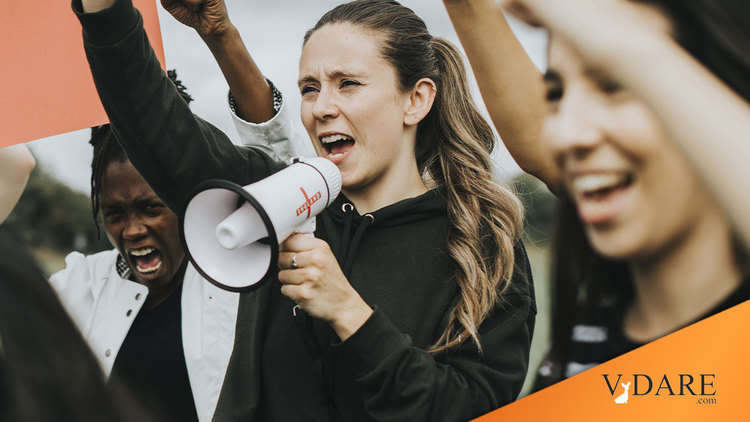


01/13/2022
From a column in The New York Times:
The Gender Gap Is Taking Us to Unexpected Places
Jan. 12, 2022
By Thomas B. Edsall
Mr. Edsall contributes a weekly column from Washington, D.C., on politics, demographics and inequality.
In one of the most revealing studies in recent years, a 2016 survey of 137,456 full-time, first-year students at 184 colleges and universities in the United States, the U.C.L.A. Higher Education Research Institute found “the largest-ever gender gap in terms of political leanings: 41.1 percent of women, an all-time high, identified themselves as liberal or far left, compared to 28.9 percent of men.”
The institute has conducted freshmen surveys every year since 1966. In the early days, until 1980, men were consistently more liberal than women. In the early and mid-1980s, the share of liberals among male and female students was roughly equal, but since 1987, women have been more liberal than men in the first year of college.
While liberal and left identification among female students reached a high in 2016, male students remained far below their 1971 high, which was 44 percent.
And shortly thereafter the draft was over…
Along parallel lines, a Knight Foundation survey in 2017 of 3,014 college students asked: “If you had to choose, which do you think is more important, a diverse and inclusive society or protecting free speech rights.”
Male students preferred protecting free speech over an inclusive and diverse society by a decisive 61 to 39. Female students took the opposite position, favoring an inclusive, diverse society over free speech by 64 to 35.
Majorities of both male and female college students in the Knight survey support the view that the First Amendment should not be used to protect hate speech, but the men were more equivocal, at 56 to 43, than women, at 71 to 29.
…Dennis Chong, a political scientist at the University of Southern California, wrote by email that “a gender gap in political tolerance, with women being somewhat more willing to censor controversial and potentially harmful ideas, goes back to the earliest survey research on the subject in the 1950s.”
There are a number of possible explanations, Chong said, including “stronger religious and moral attitudes among women; lesser political involvement resulting in weaker support for democratic norms; social psychological factors such as intolerance of ambiguity and uncertainty which translate to intolerance for political and social nonconformity; and greater susceptibility to feelings of threats posed by unconventional ideas and groups.”
In an email, Steven Pinker wrote:
We’re seeing two sets of forces that can pull in opposite directions. One set comprises the common interests of men on the one hand and women on the other. Men tend to be more obsessed with status and dominance and are more willing to take risks to compete for them; women are more likely to prize health and safety and to reduce conflict. …
When the academic world opened up to women in the 1970s and 1980s, [Jonathan] Haidt continued, “women flooded into some areas but showed less interest in others. In my experience, having entered in the 1990s, the academic culture of predominantly female fields is very different from those that are predominantly male.”
Haidt noted:
Boys and men enjoy direct status competition and confrontation, so the central drama of male-culture disciplines is ‘“Hey, Jones says his theory is better than Smith’s; let’s all gather around and watch them fight it out, in a colloquium or in dueling journal articles.” In fact, I’d say that many of the norms and institutions of the Anglo-American university were originally designed to harness male status-seeking and turn it into scholarly progress.
Women are just as competitive as men, Haidt wrote, “but they do it differently.”
He cited a 2013 paper, “The development of human female competition: allies and adversaries,” by Joyce Benenson, of Harvard’s department of human evolutionary biology. In it, Benenson writes:
From early childhood onwards, girls compete using strategies that minimize the risk of retaliation and reduce the strength of other girls. Girls’ competitive strategies include avoiding direct interference with another girl’s goals, disguising competition, competing overtly only from a position of high status in the community, enforcing equality within the female community and socially excluding other girls.
… In an email, Benenson added another dimension to the discussion of sex roles in organizational politics:
From an early age, women clearly dislike group hierarchies of same-sex individuals more than men do. Thus, while boys and men are more willing to compete directly with both higher and lower status individuals, girls and women prefer to interact with same-sex individuals of similar status. This does not mean however that girls and women don’t care about status as much as boys and men do. For both sexes, high status increases the probability that one lives longer and so do one’s children. The result of these two somewhat conflicting motives is that girls and women seek high status but disguise this quest by avoiding direct contests. This gender difference likely impacts how women seek to shape organizational culture.
The strategies Benenson and her colleagues describe, Haidt pointed out,
lead to a different kind of conflict. There is a greater emphasis on what someone said which hurt someone else, even if unintentionally. There is a greater tendency to respond to an offense by mobilizing social resources to ostracize the alleged offender.
Basically, although feminist theory assumes the opposite, men mostly compete against men and women against women. Men can cooperate while ribbing each other pretty hard. I finally watched the fine neo-Western movie Hell or High Water (script by Taylor Sheridan, creator of the hit TV show Yellowstone), in which the outlaws and the law both consist of pairs of guys constantly insulting each other while getting a lot done.
Women, in contrast, tend to compete with each other via snide remarks. So women tend to assume more that of course the authorities should silence anybody who is saying anything not nice.